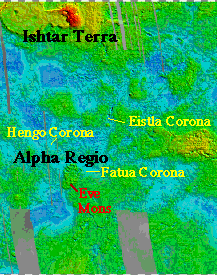This is an image of a mountain of Venus.
Click on image for full size
NASA
Venus Mountains
The four main mountain ranges of Venus are named Maxwell Montes, Frejya Montes, Akna Montes, and Danu Montes. These are found on Ishtar Terra.
Mountain ranges are formed by the folding and buckling of a planet's crust. The mountain ranges of Venus, like those of the Earth, are characterized by many parallel, linear, folds and faults.
The presence of mountain ranges on Venus may provide evidence that the planet's surface is in motion.
You might also be interested in:

What types of instructional experiences help K-8 students learn science with understanding? What do science educators teachers, teacher leaders, science specialists, professional development staff, curriculum designers, school administrators need to know to create and support such experiences?
...more
Ishtar Terra is one of the Plateau Highlands of Venus, is found near the north pole, and is about the size of the continental United States. Ishtar Terra contains the four main mountain ranges of Venus
...more
This picture shows an example of folding and faulting on Venus. The different patterns of faulting provide evidence of the stress and strain, or crustal deformation taking place on the surface. Types of
...more
This is a map of the surface of Venus (turned sideways!). Lowlands in the map are similar to an ocean bottom, and highlands resemble continents. As can be seen in the image, the surface of Venus consists
...more
Alpha Regio and Ovda Regio are examples of what is known as a "Plateau Highland" of Venus. Among the volcanic features of Alpha Regio is Eve Mons. Unlike volcanic rises, plateau highlands have few volcanoes,
...more
Aphrodite Terra, the Greek name for the goddess Venus, is about half the size of the African continent, and is to be found along Venus' equator. Aphrodite Terra is different from Ishtar Terra in that,
...more
Beta Regio and Atla Regio are examples of what is known as a volcanic rise. Volcanic rises are broad, sloping highlands over 1000 km across. They are cut by deep troughs 100-200 km across. These troughs
...more
This image clearly shows a channel where something once flowed. Without proper measurements, scientists can only guess what sort of liquid may have flowed through this channel. On Earth, such channels
...more















